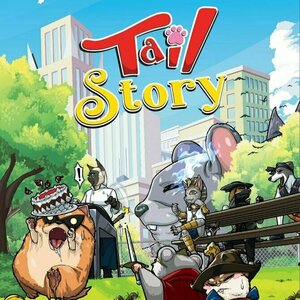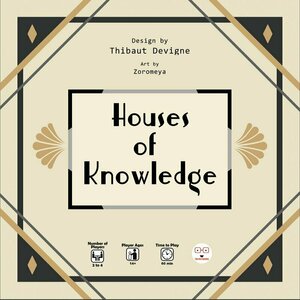Purple Phoenix Games (2266 KP) rated Tail Story in Tabletop Games
Jul 1, 2020
Disclaimer: We were provided with a preview copy of Tail Story for the purposes of this review. Some of the components pictured are not final, and will be addressed in production. Also, I do not intend to rehash the entire rulebook, but rather provide an overview of the rules and game flow. -L
Tail Story is a competitive card game in which players are racing to become the most memorable pet in history! How? By partaking in various events and gathering a total of 4 Achievements. Here’s how it works. To setup, each player takes a player mat, and randomly draws a Queue Card. Players then get to choose a Character card – a pet from either the Canine, Feline, or Rodent & Friends type. Shuffle the Event cards, deal 15 to each player, everyone draws 5 cards to their hand, and the game is ready to begin! The player who drew Queue Card 1 is the first player, and play continues in numerical order.
Each turn consists of 5 steps: Draw, Play, Bonus, Deck Check, and End of Turn. The first step is always to Draw 1 card from your deck. In the Play Step, you choose one action to perform. Each player has 2 Action Points (AP) per turn, and those are spent here in the Play Step. All Event cards require either 1 or 2 AP to play, and the other standard actions in the Play Step require either 0 or 1 AP to perform (Check out the Reference Cards pictured below to see the possible actions). After performing 1 action, you move to the Bonus Step, where a player may choose to activate a Bonus ability. The Deck Check step is next. All players count how many cards remain in their Draw piles. If all decks still have at least 1 card, you jump back to the Play Step and perform another action. If any deck is out of cards, that player reshuffles their discard pile, and places a card from their hand face-down on their player mat to signify that they have collected an Achievement. Even if another player collects an Achievement on your turn, play then returns to you, and you jump back to the Play Step again. The last step is the End of Turn – a player decides to be done and ends their turn, discarding their hand down to 5 cards. The game ends when a player has collected their 4th Achievement.
Here’s a neat twist though – whenever you play a card, any opponent can choose to play a Stop card to prevent you from performing that action! And then, if you have a Stop card too, you could play it to cancel out their Stop card. This twist adds a strategic and competitive element to the game that elevates it to the next level. There’s a fun little element of role-play too that encourages you to get into your animal character – I’ll leave that for you to discover on your own!
I know that seems like quite a lot, but once you get into the swing of things, Tail Story plays pretty quickly. One thing I particularly like about this game is that it requires a decent amount of strategy. Everyone is racing to get through their Draw decks and collect Achievements, while at the same time hindering the progress of their opponents. Are you willing to risk a valuable Stop card to cancel the action of an opponent and hope that they don’t play a Stop card back to you? Should you play a card that could activate your Bonus ability now or wait for your next action to pull a fast one over on your opponents? Your strategy has to be adjustable on the fly depending on what cards your opponents are playing. There is no single right strategy to win, and the riskiness makes the game more exciting and engaging.
Another thing I really like about Tail Story is that there are really only 4 different Event cards that can be played. Yes, the artwork may vary, but ultimately the actions are the same. They rely on key text and color coding to communicate their uses, and after a few rounds, recognizing those effects is easy. One thing I wish is that the reference cards had these effect explanation instead of only being listed in the rulebook. Just for a quick glance if you need a reminder instead of having to look back in the rules for the full text. The reference cards do have the Turn Steps and possible Actions on them, which are helpful – don’t get me wrong!
I would recommend Tail Story at the higher player counts for maximum enjoyment. With only 2 players, it feels like it drags on a bit because it is only a back-and-forth game. With 3-4 players, you have more opponents with which to interact, and playing cards against others doesn’t feel as targeted and keeps the game play more light-hearted than cut-throat.
Let’s talk about components. As I mentioned earlier, this is only a preview copy of the game, so some elements are still not finalized. The player mats are only paper right now, but I anticipate that they will be sturdier in final production. That being said, the information on the player mats is awesome. They provide enough information to understand where everything goes, while not being so wordy that they are confusing. I am excited to see what kind of color scheme they come up with for the player mats, to match the artwork of the cards. On to the cards – they are amazing. For starters, the cards are nice, sturdy, and thick. Definitely a game that will not easily succumb to bent corners or torn cards. The actual artwork of the cards is perfect. Each card is detailed, colorful, and appropriate for their respective card names. Probably the coolest part of the cards is that they all have a holographic finish on them. This really makes the artwork pop and makes you admire every card instead of just reading the text. That being said, the holographic finish makes the cards stick together a little more – not a huge detriment, but something to be aware of and careful with when drawing or playing cards! The game box is a cute little box with a magnet closure that is perfect for easy transportation.
Overall, I would say that I love Tail Story. It’s fun, fast-paced, strategic, and exciting. Being able to choose from 3 Character types (Canine, Feline, Rodent & Friends) gives you the opportunity to play a different game, with a different strategy, every time. With more plays, the special text of cards is engrained in your head, which means that it can play even faster and with no interruptions to check rules. It’s definitely a memorable game, and one that I can see myself pulling out often on game nights. I am excited to see this campaign launch, and for the sake of all animal dreams out there, you should check it out!
Purple Phoenix Games (2266 KP) rated Houses of Knowledge in Tabletop Games
Mar 26, 2020 (Updated Mar 26, 2020)
Houses of Knowledge pits 2-4 players against each other as museum curators desperately trying to fill their museums with interesting rooms and curious artifacts. In fact, a curator can end the competition once they are able to display eight lovely pieces in their halls. Beware, however, as the competition is also trying to gather the best gallery and may even attempt to pilfer your displayed items!
DISCLAIMER: We were provided a prototype copy of this game for the purposes of this review. These are preview copy components, but the final components will be exactly the same as these shown, if the pending Kickstarter campaign is successful. Also, it is not my intention to detail every rule in the game, but to give our readers a general feel for how the game plays. You can back the game through the Kickstarter campaign, order from your FLGS, or purchase through any retailers stocking it after fulfillment. -T
Setting up a game of Houses of Knowledge is quite a feat, as different decks need to be assembled according to player count. Refer to the rules to setup each deck. Once the decks are prepared and starting cards dealt to each player, create the Items and Actions markets by revealing six cards from each deck and assigning cost discs in decending order from the draw decks. Furthest away from the two draw decks will be placed the deck of Room cards, with two visible and available for purchase. These rooms will receive the leftover 5-value cost disc. Set the monicash aside to be used as a central bank. Determine the starting player and you are ready to begin!
Luckily, the game furnishes the players with reference cards so that all players have access to all options they are afforded on their turns. The first thing that happens on a turn is collecting income. Each turn a player earns 3 monicash (MC) plus the amounts earned from Rooms in their tableau. From here a turn has several options: buying Items or Actions from the market to your hand, paying 2 MC to play a card from your hand to your tableau, selling two cards for 2 MC, and buying Room cards.
When a player buys an Item or Action card from the market the new card is taken in hand, paying the cost shown on the cost disc either above or below the card taken. To play a card from hand, the player pays 2 MC to the bank and places an Item onto a corresponding Room card, or plays an Action card either on their own tableau or against an opponent.
Play continues in this fashion until one player is displaying eight Items in their Rooms or the draw decks are depleted. The round finishes completely so all players have an equal amount of turns, and then points are tallied and summed to determine the greatest curator and winner of Houses of Knowledge!
Components. As I mentioned in my disclaimer, we were provided a copy of this game for this preview. All components we were provided are finalized, so everything you see pictured here is how it will be upon a successful Kickstarter campaign. That said, the components are fantastic! The cards are good quality, the cost discs are good cardboard chips, and the money is the faux-paper money we are starting to see in games nowadays – and thank heavens for that! No more cheap Monopoly money! Oh by the way, the art on this one is superb and very chic. I love it!
So the game looks and feels great, but does it play well? YES. This one is excellent! At first it feels too simple because it is relatively easy to collect Rooms and Items to fit on those Rooms, so you think, “Heck, I can get eight Items in like four rounds!” That is, until your opponents hit you with some of the Action cards they’ve been hoarding unseen by you. One “friend” maybe steals one of your Items because you neglected to assign Guards to it, or the “pal” just before you in initiative order rearranges the Item cards so that the ones you wanted are now much more expensive, thus throwing your carefully-planned tactics down the drain. Ooh, it’s great tension! My one gripe: I wish it was longer so that I could really stick it to my enem- uhh, friends.
If you are a fan of card games that pack more of a punch than it first seems, and games that keep you wanting more, whilst giving you a grand feeling of quirky opulence, then you should certainly check out Houses of Knowledge. We are happy to recommend this one. Go back it on Kickstarter when the campaign begins!
Purple Phoenix Games (2266 KP) rated WizBang! in Tabletop Games
Aug 3, 2020
A-la-kalhambra! A wizard’s duel has been accepted between you and your rival. Based on the whims of judges wanting displays of specific and ever-changing magic-types, you must cast a flurry of impressive spells to best your opponent. The duel will last exactly 6 rounds and the greatest spellslinger will reign supreme.
DISCLAIMER: We were provided a prototype copy of this game for the purposes of this review. These are preview copy components, and the final components may be different from these shown. Also, it is not my intention to detail every rule in the game. You are invited to download the rulebook, back the game through the Kickstarter campaign launching in August, or purchase through any retailers stocking it after fulfillment. -T
WizBang! is a two-player card dueling game akin to a mashup of War and Crazy 8s. To setup, shuffle the large deck of WizBang! cards, and deal 30 to each player. Similarly, shuffle the small deck of Extra Trick Up My Sleeve cards and deal four to each player. Roll the magic die, place it on the Round 1 section of the round tracking card and the game is ready to begin!
A game of WizBang! is short, sweet, and light on rules. Perfect for that lockdown date night. The game lasts 6 rounds, and each round consists of playing five cards. First things first – roll that magic die. Yellow is Shiny magic, green is Slimy magic, and purple is Weird magic. This means that for the duration of the round, the judges only care about the values that correspond with the rolled magic type. So if Shiny is rolled, each card played (a la War) will compare Shiny values. Highest number wins both cards to the player’s VP stack.
However, Extra Trick Up My Sleeve cards can be played at any time, and can affect either yourself or your opponent. I have included some of those below. These cards do not count for VP at game end, but can certainly shake things up quite a bit during a round. In addition to these special cards, included in the WizBang deck are several Wizard cards that change the preferred magic type for the round or just for one trick. Once all six rounds have been played players count up their VP Spell cards and majority wins! If no majority: SUDDEN DEATH round.
Components. As I mentioned previously, we were provided a prototype copy of the game, but were assured that it is very close to the final version. This game is a bunch of cards and one die. The cards are nice and a little glossy, with sometimes funny art, and even better inside jokes on them. The die is nice quality and easy to interpret which magic source is being judged. All in all the components are good.
I also stated previously that this game is quick. The box says around 10-15 minutes and that’s spot on. I can see seasoned players being able to knock out a game in 5, but for the first few games we were in that 10-15 minute range. What I like about the game is that it is quick. We were needing something to fill a short timeframe, so I broke this one out, taught it to my wife, and played through once or twice before a child needed Mommy. So it definitely fits that bill.
However, the game play itself is a little lacking. Don’t get me wrong – I would play this again, and I would even use it to help teach my son (4 years old) several gaming concepts, but without using the cheat cards. It is basically a combination of War (play a card, winner takes both) and Crazy 8s/UNO (constantly changing trumps) with a wizard duel theme. I love wizards/fantasy themes in my games, so I am still somewhat drawn to this, but ultimately, if I want to play War or Crazy 8s, I might simply break out a normal deck of playing cards to do so.
The game is not at all bad. I really want to stress this. Just for gamers, it is a bit elementary. This would be great in a library’s game collection, or for educational purposes, or even simply as a quick filler game if you want a theme for your War/Crazy 8s hankerin. Need a game for younger gamers? Yes, this. Need a quick game for grandparents or in-law nongamers? This. Don’t know what to play and you’re running out of time (happens to me OFTEN)? This. If you need something like WizBang! in your collection to fill a 2-player fantasy card game hole, definitely check this one out.
Rikki Hammond (33 KP) rated Carcassonne in Tabletop Games
May 23, 2019
The rules of Carcassonne are very simple. Each player will pick a random tile from a stack, and starting with the first player (who always starts with the same beginning tile) will place their tile, so that it connects to one or more adjacent tiles. Each tile will have a road, city or church on it. Roads can only connect with roads, cities with cities, and churches around either of these.
Once a tile is placed, the player can then choose to place one of their meeples on it, either on a road, city, church, or surrounding field. Once that particular area is completed (a road connects to a town, city or church on either end or a city is completely walled around) then that meeple scores you points. 1 point for each section of road per tile, 2 points for each city piece per tile (double if that city tile has a shield on it) and you will score 9 points if you manage to completely surround a church with 8 other tiles. Once the meeple scores, the player removes it from the tile, and can be used again on another tile.
Play continues like this until the tile stack is depleted, then some endgame scoring occurs, where unfinished roads, churches and cities score 1 point per tile in the area. If farmers were used (laying a meeple face down on a field) then 3 points are scored per completed city in that field area. If ever two meeples share the same city, road or field through future tile placements, then each player will get the same points, and whoever has the most points at the end, is the winner.
Carcassone plays between 2 to 5 players, and having played with all player counts, I can say that it plays well, no matter how many players are there. The components are great. The tiles are colourful, and one the game is over, you can build some pretty impressive landscapes. Each player will have different coloured meeples, so it's easy to tell whose is whose, and the score tracker is a handy addition.
My only criticisms I can find is that, after playing a few games, you find that there's not much in the way of variety when it comes to placement of the tiles, and some more hardcore gamers could class this game as too simple. But these are very minor niggles.
Personally, I think Carcassonne is a fantastic first step for people who may not have played many board or tile games before, and if you do get tired if it, there are tonnes of expansions for it, which can add more variety to the game.

Pocket Wiki for Stardew Valley
Reference and Utilities
App
Looking for help or the latest tips for the game Stardew Valley? This all-in-one solution is exactly...

Drift Mania Championship 2
Games and Sports
App
With millions of players worldwide, the #1 Drift game on the App Store is finally back! Drift Mania...

Sky Gamblers: Cold War
Games
App
THE NEXT GENERATION OF AIR COMBAT GAMING IS HERE! With an extensive single player campaign and a...

Polyphony synthesizer with a low delay (low latency musical synth) and distortion HD version
Music and Utilities
App
Video: http://youtu.be/qNADBoucaRk A microtonal capable distortion synthesizer with an 11-string...

NBA JAM by EA SPORTS™
Games and Entertainment
App
BOOMSHAKALAKA!!! Jam with a friend in Local Multiplayer and rock your iPhone or iPod touch with all...




